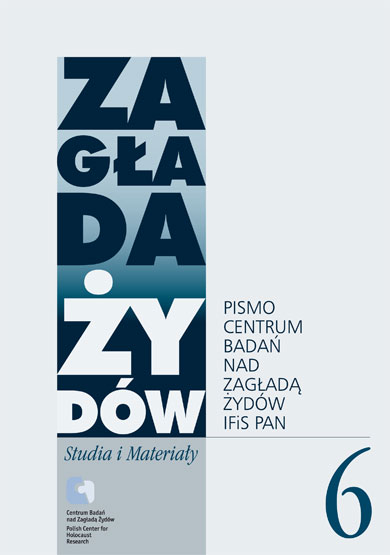Kicz w kinie holokaustowym
Zagłada Żydów. Studia i Materiały, Nr 6 (2010), Strony: 55-73
Data zgłoszenia: 2020-12-06Data publikacji: 2010-12-30
 https://doi.org/10.32927/zzsim.706
https://doi.org/10.32927/zzsim.706
Abstrakt
The text deals with popular cinema that touches upon the subject matter of the Holocaust and the kitsch esthetics which is either intentionally or unintentionally often adopted in such films. The main questions to which the author seeks the answer is: why do we need kitsch to create stories about the Holocaust? The author defines the term Holocaust film and then suggests a typology of Holocaust films with respect to cultural references and narrative archetypes of stories which are often used in such films. Different types of Holocaust films are presented: Christian kitsch, Zionist kitsch, pathos kitsch and magic ending kitsch. The kitsch is treated here not as a critical category but as an esthetics having its own power and positive meaning. Nevertheless, the text refers to the ongoing debate about the subject matter of kitsch its one-sided perception, on the one hand, as esthetics destroying art and sensitivity, and on the other, as a necessary and creative element of culture.
Słowa kluczowe
kino o holokauście , kicz , kultura popularna , happy-end , kamp
Licencja
Prawa autorskie (c) 2010 Autor & "Zagłada Żydów. Studia i Materiały"

Utwór dostępny jest na licencji Creative Commons Uznanie autorstwa 4.0 Międzynarodowe.
https://creativecommons.org/licenses/by/4.0
Podobne artykuły
- Anna M. Rosner, Kindertransporty – brytyjskie akcje ratowania żydowskich dzieci w latach 1938–1939 , Zagłada Żydów. Studia i Materiały: Nr 12 (2016)
- Jacek Leociak, Marta Tomczok, Afektywny kicz holokaustowy – wprowadzenie , Zagłada Żydów. Studia i Materiały: Nr 17 (2021)
- Marcin Zaremba, Szaber Frenzy , Zagłada Żydów. Studia i Materiały: 2010: Holocaust Studies and Materials
- Marcin Zaremba, Gorączka szabru , Zagłada Żydów. Studia i Materiały: Nr 5 (2009)
- Michał Trębacz, „Cieszę się, że Państwo Putersznyt przeżyli wojnę i są ze sobą szczęśliwi”. Ryszard Lerczyński – jedyny łódzki Sprawiedliwy , Zagłada Żydów. Studia i Materiały: Nr 16 (2020)
- Jan H. Issinger, Frankenstein w warszawskim getcie. Historia i legenda , Zagłada Żydów. Studia i Materiały: Nr 12 (2016)
- Gabriel Finder, Proces Szepsla Rotholca a polityka kary w następstwie Zagłady , Zagłada Żydów. Studia i Materiały: Nr 2 (2006)
- Katarzyna Person, Hersz Wasser. Sekretarz Archiwum , Zagłada Żydów. Studia i Materiały: Nr 10 (2014)
- Boaz Tall, Sądzenie tych którzy nie mogą być sądzeni – procesy kolaborantów w Izraelu , Zagłada Żydów. Studia i Materiały: Nr 2 (2006)
- Natalia Sineaeva-Pankowska, Pamięć o Holokauście w Mołdawii , Zagłada Żydów. Studia i Materiały: Nr 11 (2015)
Możesz również Rozpocznij zaawansowane wyszukiwanie podobieństw dla tego artykułu.
 English
English
 Język Polski
Język Polski








